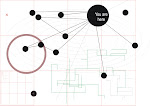Space is shrinking, place is disappearing. Most writers on place would say that the current state of place is not just the result of Modern philosophy. The loss of place is, for many, a profound crisis, which is why it has resurfaced in academia across the disciplines. Besides the fragmentation and privatization of culture, many suggest combinations of mass communications, increased mobility, and consumer society as key players in the demise of place. Consumer society has actually helped create “non-places”[1] by the shear replication of places across the country and around the world; often referred to as the McDonaldization or homogenization of culture. Non-places like the Gap, Starbucks, McDonalds, as well as, airports, freeways, and supermarkets are said to be constituted by irrelevant memories and traditions.[2] These places tell us nothing about the larger spatial context of the community and are basically the same from city to city and country to country. What results is a relativity and disposability of place.
Many feel that mobility or tourism and consumption are dangerous to place. Tourism is a fascination with place without identifying with it. Tourists come in, consume, and leave. Other than the economic boost that tourism offers, no real construction of place is made, except for the nostalgia of the tourists.
Many also see that the private and public divide has had crucial effects on our conceptions of place in American society. Sheldrake discusses this modern divide between interiority and exteriority by suggesting that “exposure has the connotation of a threat rather than the enhancement of life.”[3] As a result, city planning focuses on consumer needs (which is really a public venue for the private life) and creating safe distinctions between people groups (gated communities are a great example). “Public space thus becomes bland and neutralized as its main purpose is to facilitate movement across it rather than encounters within it.”[4] He continues by saying that for the city to recover, the outer life needs to be rediscovered. Perhaps that is why city planning is changing tactics to reconstruct the idea of the neighborhood trying to encourage community.[5]
[1] Cresswell, 46. Cresswell picks up on Marc Auge’s term.
[2] Ibid., 43.
[3] Sheldrake 149.
[4] Ibid., 149. So much more could be said about the loss of place due to architectural changes especially within the church architecture. The same blandness and utility seems to the norm for many new churches.
[5] William Leach has written “Country of Exiles: The Destruction of Place in American Life” where he explores this and other phenomena of the loss of place in America. I did not get to this text this semester but it looks fascinating.
skip to main |
skip to sidebar


An axis of access is a sacred place which our life revolves around. We hold them dear in our memory. They thrive in our imagination. They root us to this world. (To read more about the nature of this blog read the originating post from 08.07.07)
About Me

- rstander
- Grand Forks, ND, United States
- i am recent MFA grad from University of North Dakota. while i have range of interests, my ongoing research continues to explore the nature of place/space through artistic and liturgical lenses.
Blog Archive
-
▼
2007
(58)
-
▼
October
(13)
- Contemporary Place of Place
- God, be merciful to me, a sinner!
- Place & Space in History
- Space & Place
- Peniel: Jacob and Sacred Space
- Sioux Falls Seminary as Sacred Space
- Habits of the Heart - Robert Bellah pt. 4
- Habits of the Heart - Robert Bellah pt. 3
- Habits of the Heart - Robert Bellah pt. 2
- Habits of the Heart - Robert Bellah pt. 1
- Ways of Seeing
- prodigal rat?
- the achilles of christian theology
-
▼
October
(13)
Labels
- abandonment
- aesthetics
- architecture
- Art
- artists
- books
- canada
- cartography
- commodified memory
- consumerism
- contested space
- CTS-AAR Photos
- Devotions
- Elevator Series
- Film
- graffiti
- individualism
- iowa
- kitsch
- lectionary readings
- liturgy
- Luke
- Mark
- minnesota
- misc.
- misc. education
- Montana
- music
- nationalism
- new topographics
- North Dakota
- northwestern college
- photographers
- photography
- pilgrimage
- PKAP
- priests in film
- printmaking
- Psalms
- questioning God
- religion as a chain of memory series
- retro signage
- sacred space
- saskatchewan
- scripture
- shoes
- sioux falls seminary
- south dakota
- stray shopping carts
- TH 541
- theological musings
- threshold series
- University of North Dakota
- Video
- visiting artists
- weather reports
Explore
- University of North Dakota
- Sioux Falls Seminary
- Northwestern College
- The Chronicle of Higher Education
- Inside Higher Ed
- College Theology Society
- Image Journal
- Christians in the Visual Arts (CIVA)
- College Art Association
- National Association of Baptist Professors of Religion (NABPR)
- American Academy of Religion
- The Ekklesia Project
- Speaking of Faith
- NT Wright Page
- Textweek.com
- Good Shepherd Episcopal
- Internet Movie Data Base (IMDB)
- The Simpson's
Exhibition Opportunities
Theology & The Arts
Theology and the Arts Academic Programs
My Blog List






